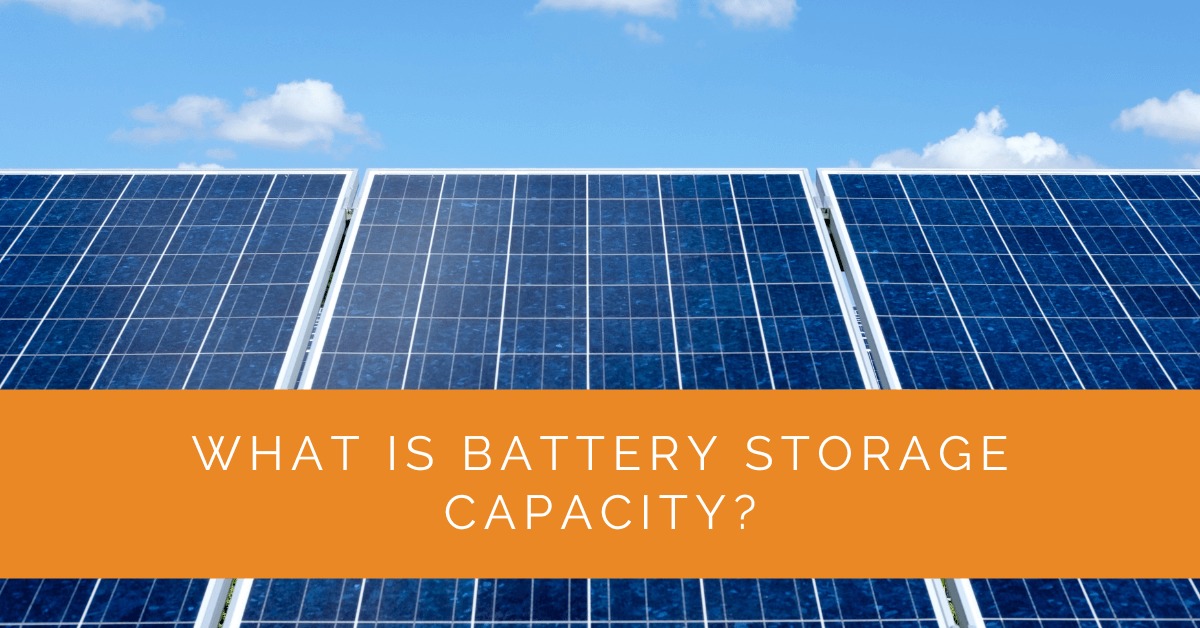Battery storage plays a crucial role in maximizing the potential of renewable energy systems. One essential aspect of battery storage is its capacity. This article will delve into battery storage capacity, its significance, and how it impacts system performance.
Contents
- 1 Key Takeaways
- 2 Understanding Battery Storage
- 3 What is Battery Storage Capacity?
- 4 Factors Influencing Battery Storage Capacity
- 5 Calculating Battery Storage Capacity
- 6 Optimizing Battery Storage Capacity
- 7 Case Study: Maximizing Battery Storage Capacity for Renewable Energy Systems
- 8 Expert Insights From Our Solar Panel Installers About Battery Storage Capacity
- 9 Experience Solar Excellence with Us!
- 10 Conclusion
- 11 FAQ
Key Takeaways
- Battery storage capacity refers to the maximum amount of electrical energy a battery can store, influencing system performance and effectively meeting energy demands.
- Factors such as battery chemistry, state of charge (SOC), depth of discharge (DOD), temperature, and aging affect battery storage capacity.
- Calculating and optimizing battery storage capacity through accurate formulas, proper management, integration with renewable sources and grid systems, and advanced control systems enhance overall system efficiency and contribute to a sustainable energy future.
Understanding Battery Storage
Battery storage is a pivotal component in the realm of renewable energy systems, serving as a crucial bridge between energy generation and consumption. By comprehending the intricate workings of battery storage, we can fully grasp its significance in the sustainable energy landscape.
What is Battery Storage Capacity?
At the heart of battery storage lies its capacity, which determines the maximum amount of electrical energy a battery can store. This capacity plays a pivotal role in determining the system’s overall performance and ability to meet energy demands effectively. Let’s delve deeper into the concept of battery storage capacity and its implications for renewable energy systems.
Factors Influencing Battery Storage Capacity
Multiple factors come into play when considering battery storage capacity, each influencing its performance and overall capabilities. By understanding these factors, we can make informed decisions regarding battery selection and system design.
Battery Chemistry and Technology
The choice of battery chemistry and technology is crucial in determining the storage capacity. Various battery types, such as lithium-ion, lead-acid, or flow batteries, offer different capacities, energy density, and cycle life characteristics. We can optimize storage capacity by selecting the appropriate battery chemistry to suit specific energy storage requirements.
State of Charge (SOC) and Depth of Discharge (DOD)
The state of charge (SOC) refers to the current energy level of the battery, represented as a percentage of its total capacity. The depth of discharge (DOD) signifies the energy withdrawn from the battery during each cycle. Both SOC and DOD significantly impact battery performance and storage capacity. Maintaining an appropriate SOC range and avoiding deep discharges can enhance the overall longevity and capacity of the battery.
Temperature and Environmental Conditions
Temperature is a critical factor affecting battery performance and storage capacity. Extreme temperatures, whether too high or too low, can adversely affect battery efficiency and overall storage capabilities. We can safeguard battery capacity and extend its lifespan by ensuring optimal operating temperatures through appropriate thermal management.
Aging and Degradation of Batteries
Batteries naturally undergo aging and degradation over time, resulting in a gradual reduction in storage capacity. Factors such as the number of charge-discharge cycles and the battery’s overall lifespan can influence its long-term storage capabilities. Understanding the aging characteristics and degradation mechanisms specific to the chosen battery chemistry allows us to estimate and manage the capacity loss effectively.

Calculating Battery Storage Capacity
Accurately calculating battery storage capacity is essential for designing and optimizing energy storage systems. We can estimate its storage capacity with greater precision by employing the appropriate formulas and understanding the battery’s voltage and ampere-hour rating.
The formula commonly used for calculating storage capacity is:
Storage Capacity (kWh) = Voltage (V) × Ampere-hours (Ah)
We can estimate the storage capacity in kilowatt-hours (kWh) by multiplying the battery’s voltage with its ampere-hour rating. It is crucial to consult the manufacturer’s specifications to ensure accurate calculations and consider any additional factors specific to the battery technology used.
Optimizing Battery Storage Capacity
Various optimization strategies can be employed to unlock the full potential of battery storage capacity. By implementing these techniques, we can enhance the battery storage system’s overall performance, efficiency, and lifespan.
Proper Battery Management and Maintenance
Regular battery management and maintenance practices are vital for ensuring optimal storage capacity. Monitoring the state of charge, maintaining appropriate temperature conditions, and conducting routine inspections contribute to preserving and maximizing battery storage capacity. By adhering to manufacturer guidelines and best practices, we can extend the battery’s lifespan and sustain its performance over time.
Integration with Renewable Energy Sources and Grid Systems
Integrating battery storage with renewable energy sources, such as solar or wind power, allows for capturing and storing excess energy. This integration enables a balanced energy supply and demand, leveraging the battery’s storage capacity to optimize renewable energy utilization. Furthermore, connecting battery storage systems to the grid facilitates bidirectional energy flow, ensuring a more efficient and resilient energy ecosystem.
Use of Advanced Control and Monitoring Systems
Employing advanced control and monitoring systems enables real-time data acquisition and analysis, leading to proactive management of battery storage systems. These systems provide insights into battery performance, health, and efficiency. By leveraging this information, operators can optimize charging and discharging cycles, balance energy flow, and maintain storage capacity over the battery’s lifecycle.
Case Study: Maximizing Battery Storage Capacity for Renewable Energy Systems
Background
At Solar Panels Network USA, we understand the importance of optimizing battery storage capacity to enhance the performance of renewable energy systems. One of our recent projects involved a residential client looking to integrate a battery storage system with their existing solar panel setup. The goal was to ensure reliable energy storage and efficient power usage to maximize the benefits of their renewable energy investment.
Project Overview
The project aimed to design and install a battery storage system that would complement the client’s solar panels, providing a consistent power supply and reducing reliance on the grid. The client required a solution that could store excess energy generated during the day for use during peak demand periods and at night.
Implementation
Assessment and Planning
- Energy Needs Evaluation: We conducted a thorough assessment of the client’s energy consumption patterns, including daily and seasonal variations. This evaluation helped determine the optimal battery storage capacity required to meet their needs.
- Battery Selection: Based on the assessment, we selected high-capacity lithium-ion batteries known for their efficiency, longevity, and high energy density. These batteries were chosen to provide sufficient storage capacity and support the client’s energy demands effectively.
Installation Process
- System Integration: We integrated the battery storage system with the existing solar panels and grid connection. The setup included advanced control and monitoring systems to manage the charging and discharging cycles, ensuring optimal performance and energy utilization.
- Thermal Management: To address potential temperature-related issues, we implemented a thermal management system to maintain the batteries within the optimal temperature range. This ensured consistent performance and extended the lifespan of the battery storage system.
- Monitoring and Optimization: Real-time monitoring systems were installed to track the state of charge (SOC), depth of discharge (DOD), and overall performance of the battery storage system. This allowed for proactive adjustments and maintenance to maximize efficiency and capacity.
Results
- Enhanced Energy Efficiency: The integrated battery storage system significantly improved the client’s energy efficiency. Excess energy generated during the day was effectively stored and used during peak demand periods, reducing reliance on grid power and lowering electricity bills.
- Reliable Power Supply: The system provided a reliable power supply, ensuring the client had access to stored energy during nighttime and cloudy days. The advanced control systems optimized energy flow, balancing the energy supply and demand seamlessly.
- Long-Term Performance: The thermal management system and regular monitoring contributed to the long-term performance and longevity of the battery storage system. The client experienced consistent storage capacity and efficiency, with minimal degradation over time.
Summary
This case study highlights the importance of accurately calculating and optimizing battery storage capacity for renewable energy systems. Solar Panels Network USA successfully designed and implemented a battery storage solution that met the client’s energy needs, enhanced efficiency, and ensured a reliable power supply. By focusing on proper battery selection, integration, and thermal management, we maximized the storage capacity and overall performance of the renewable energy system.
Expert Insights From Our Solar Panel Installers About Battery Storage Capacity
Choosing the right battery with adequate storage capacity is critical for maximizing the efficiency of your renewable energy system. Ensure you select a battery that matches your energy needs and consider factors like depth of discharge and state of charge for long-term performance.
Lead Solar Technician
Understanding how temperature and environmental conditions affect your battery is essential. Extreme temperatures can significantly reduce battery storage capacity, so proper thermal management is crucial to maintain optimal performance and longevity.
Solar Energy Specialist
Regular maintenance and monitoring are key to preserving your battery storage capacity. Implementing advanced control systems helps track performance in real-time, allowing for proactive adjustments to enhance efficiency and extend the battery’s lifespan.
Solar Installation Expert
Experience Solar Excellence with Us!
Trust in Solar Panels Network USA, where our seasoned experts deliver top-quality solar solutions for homes and businesses nationwide. With a legacy of countless successful installations and a commitment to sustainable energy, we’re your reliable partner in the solar journey. Ready for a brighter, eco-friendly future? Call us now at (855) 427-0058 and harness the power of the sun!
Conclusion
Understanding battery storage capacity is paramount in harnessing the true potential of renewable energy systems. By comprehending the intricate interplay of various factors, accurately calculating storage capacity, and implementing optimization strategies, we can unlock the full potential of battery storage. With proper management and integration, battery storage systems become indispensable assets in our journey toward a sustainable, cleaner energy future.
FAQ
What is the meaning of battery storage capacity?
Battery storage capacity refers to the maximum amount of electrical energy a battery can store. It indicates the battery’s ability to hold and deliver energy when needed.
What is the best battery storage level?
The best battery storage level depends on the energy system’s specific requirements and the battery’s intended use. Maintaining the battery within a safe and optimal state of charge (SOC) range, typically between 20% and 80%, is generally recommended to balance longevity and capacity.
How do I check battery storage capacity?
You can consult the manufacturer’s specifications and documentation to check battery storage capacity. The capacity is often listed in kilowatt-hours (kWh) or watt-hours (Wh). Advanced battery management systems may also provide real-time data on the battery’s state of charge, allowing you to monitor its storage capacity.
How can I increase battery storage capacity?
Increasing battery storage capacity can be achieved through various means:
- Choosing a battery with a higher capacity rating.
- Implementing effective battery management practices, such as maintaining optimal operating temperatures, avoiding deep discharges, and regular maintenance.
- Integrating multiple batteries in parallel to increase the overall storage capacity.
What is the difference between battery capacity and battery power?
Battery capacity refers to the maximum amount of electrical energy a battery can store, usually measured in kilowatt-hours (kWh). On the other hand, battery power refers to the rate at which a battery can deliver energy, measured in kilowatts (kW). While capacity indicates the amount of energy stored, power represents the ability to deliver that energy over time.
About the Author
Solar Panels Network USA stands at the forefront of solar energy solutions, driven by a team of seasoned solar engineers and energy consultants. With over decades of experience in delivering high-quality solar installations and maintenance, we are committed to promoting sustainable energy through customer-centric, tailored solutions. Our articles reflect this commitment, crafted collaboratively by experts to provide accurate, up-to-date insights into solar technology, ensuring our readers are well-informed and empowered in their solar energy decisions.

